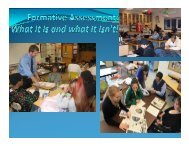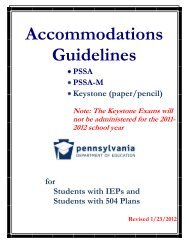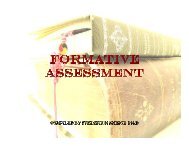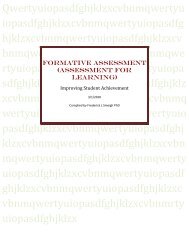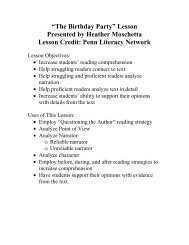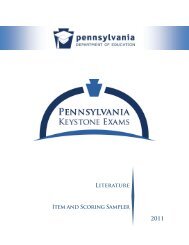Questioning in BLOOM'S REVISED TAXONOMY.pdf
Questioning in BLOOM'S REVISED TAXONOMY.pdf
Questioning in BLOOM'S REVISED TAXONOMY.pdf
You also want an ePaper? Increase the reach of your titles
YUMPU automatically turns print PDFs into web optimized ePapers that Google loves.
Frederick Smeigh
Bloom's Taxonomy is a classification of<br />
th<strong>in</strong>k<strong>in</strong>g organized by level of complexity.<br />
1. It gives teachers and students an<br />
opportunity to learn and practice a range of<br />
th<strong>in</strong>k<strong>in</strong>g.<br />
2. It provides a simple structure for many<br />
different k<strong>in</strong>ds of questions and th<strong>in</strong>k<strong>in</strong>g.<br />
3. It is vital to the <strong>in</strong>structional design of<br />
lessons.
Before we can<br />
it.<br />
Before we can<br />
it.<br />
a concept we have to<br />
the concept we must<br />
Before we it we must be able to it<br />
Before we can<br />
it.<br />
Before we can<br />
its impact we must have<br />
we must have<br />
and
Critical Th<strong>in</strong>k<strong>in</strong>g Activity Relevant Sample Verbs Sample Assignments<br />
Retriev<strong>in</strong>g, recogniz<strong>in</strong>g,<br />
and recall<strong>in</strong>g relevant<br />
knowledge from long-term<br />
memory, e.g. f<strong>in</strong>d out, learn<br />
terms, facts, methods,<br />
procedures, concepts<br />
Acquire,<br />
Def<strong>in</strong>e,<br />
Describe,<br />
Duplicate,<br />
Dist<strong>in</strong>guish,<br />
Draw,<br />
F<strong>in</strong>d,<br />
List,<br />
Match,<br />
Reproduce<br />
Recall<br />
Relate,<br />
State<br />
1. Def<strong>in</strong>e each of<br />
these terms:<br />
encomienda,<br />
conquistador,<br />
gaucho.<br />
2. What was the<br />
Amistad?<br />
3. Make a concept<br />
map of the topic.<br />
4. Make a chart<br />
show<strong>in</strong>g…
Critical Th<strong>in</strong>k<strong>in</strong>g Activity Relevant Sample Verbs Sample Assignments<br />
Construct<strong>in</strong>g mean<strong>in</strong>g from<br />
oral, written, and graphic<br />
messages through<br />
<strong>in</strong>terpret<strong>in</strong>g, exemplify<strong>in</strong>g,<br />
classify<strong>in</strong>g, summariz<strong>in</strong>g,<br />
<strong>in</strong>ferr<strong>in</strong>g, compar<strong>in</strong>g, and<br />
expla<strong>in</strong><strong>in</strong>g.<br />
Understand uses and<br />
implications of terms, facts,<br />
methods, procedures,<br />
concepts<br />
Compare<br />
Classify<br />
Describe<br />
Discuss<br />
Expla<strong>in</strong><br />
Restate<br />
Demonstrate,<br />
Fill <strong>in</strong>,<br />
F<strong>in</strong>d,<br />
Group,<br />
Outl<strong>in</strong>e,<br />
Paraphrase<br />
Recognize<br />
Report<br />
Represent,<br />
Trace<br />
1. Compare an<br />
<strong>in</strong>vertebrate with a<br />
vertebrate.<br />
2. Use a set of symbols<br />
and graphics to draw<br />
the water cycle.<br />
3. Paraphrase this<br />
chapter <strong>in</strong> the book.<br />
4. Prepare a flow chart<br />
to illustrate the<br />
sequence of events.<br />
5. Illustrate the ma<strong>in</strong><br />
idea.
Critical Th<strong>in</strong>k<strong>in</strong>g Activity Relevant Sample Verbs Sample Assignments<br />
Carry<strong>in</strong>g out or us<strong>in</strong>g a<br />
procedure through<br />
execut<strong>in</strong>g, or<br />
implement<strong>in</strong>g<br />
Make use of, apply<br />
practice theory, solve<br />
problems<br />
Use <strong>in</strong>formation <strong>in</strong> new<br />
situations<br />
Convert<br />
Classify<br />
Demonstrate<br />
Differentiate between<br />
Discover<br />
Discuss<br />
Exam<strong>in</strong>e<br />
Experiment<br />
Prepare<br />
Produce<br />
Illustrate<br />
Record<br />
Solve<br />
1. Convert the follow<strong>in</strong>g<br />
<strong>in</strong>to a real-world<br />
problem: velocity =<br />
dist./time.<br />
2. Experiment with<br />
batteries and bulbs to<br />
create circuits.<br />
3. Make a topographic<br />
map.<br />
4. Construct a model to<br />
display how<br />
someth<strong>in</strong>g looks or<br />
works.<br />
5. Practice and perform<br />
a play
Critical Th<strong>in</strong>k<strong>in</strong>g Activity Relevant Sample Verbs Sample Assignments<br />
Break<strong>in</strong>g material <strong>in</strong>to<br />
constituent parts,<br />
determ<strong>in</strong><strong>in</strong>g how the parts<br />
relate to one another and<br />
to an overall structure or<br />
purpose through<br />
differentiat<strong>in</strong>g, organiz<strong>in</strong>g,<br />
and attribut<strong>in</strong>g.<br />
Take concepts apart,<br />
break them down, analyze<br />
structure, recognize<br />
assumptions and poor<br />
logic, evaluate relevancy<br />
Appraise<br />
Compare<br />
Calculate<br />
Contrast<br />
Critize<br />
Differentiate<br />
Diagram<br />
Discrim<strong>in</strong>ate<br />
Dist<strong>in</strong>guish<br />
Exam<strong>in</strong>e<br />
Experiment<br />
Expla<strong>in</strong><br />
Form generalizations,<br />
Put <strong>in</strong>to categories<br />
Illustrate<br />
Take apart<br />
Transform<br />
1. Illustrate examples of<br />
two earthquake types.<br />
2. Dissect a crayfish<br />
and exam<strong>in</strong>e the body<br />
parts.<br />
3. Use a Venn Diagram<br />
to show how two<br />
items are alike and<br />
different.<br />
4. Construct a graph to<br />
illustrate selected<br />
data.<br />
5. Make a family tree<br />
show<strong>in</strong>g<br />
relationships.
Critical Th<strong>in</strong>k<strong>in</strong>g Activity Relevant Sample Verbs Sample Assignments<br />
Mak<strong>in</strong>g judgments<br />
based on criteria and<br />
standards through<br />
check<strong>in</strong>g and critiqu<strong>in</strong>g.<br />
Set standards, judge<br />
us<strong>in</strong>g standards,<br />
evidence, rubrics,<br />
accept or reject on basis<br />
of criteria<br />
Appraise<br />
Argue<br />
Award<br />
Critique<br />
Criticize<br />
Defend<br />
Interpret<br />
Judge<br />
Measure<br />
Predict<br />
Prioritize<br />
Select<br />
Test<br />
Validate<br />
Verify<br />
1. Defend or negate the<br />
statement: "Nature<br />
takes care of itself."<br />
2. Judge the value of<br />
requir<strong>in</strong>g students to<br />
take earth science.<br />
3. Prepare a case to<br />
present your views on<br />
a topic.<br />
4. Evaluate a character’s<br />
action <strong>in</strong> a story.<br />
5. Write a persuasive<br />
speech argu<strong>in</strong>g for<br />
and aga<strong>in</strong>st.
Critical Th<strong>in</strong>k<strong>in</strong>g Activity Relevant Sample Verbs Sample Assignments<br />
reorganiz<strong>in</strong>g elements <strong>in</strong>to a<br />
new pattern or structure<br />
through generat<strong>in</strong>g,<br />
plann<strong>in</strong>g, or produc<strong>in</strong>g<br />
put th<strong>in</strong>gs together; br<strong>in</strong>g<br />
together various parts;<br />
write theme,<br />
present speech,<br />
plan experiment<br />
put <strong>in</strong>formation together <strong>in</strong><br />
a new & creative way<br />
Assemble<br />
Blend<br />
Create<br />
Compose<br />
Construct<br />
Deduce<br />
Design<br />
Devise<br />
Forecast<br />
Formulate<br />
Imag<strong>in</strong>e<br />
Invent<br />
Organize<br />
Plan<br />
Present<br />
Rearrange<br />
Rewrite<br />
Synthesize<br />
1. Create a<br />
demonstration to<br />
show various<br />
chemical properties<br />
2. Devise a method to<br />
teach others about<br />
magnetism.<br />
3. Design a new<br />
monetary system.<br />
4. Design a robot to do<br />
homework.<br />
5. Invent a car that runs<br />
on landfill waste.
• It creates common ground for discussion<br />
about educational goals and objectives.<br />
• It helps assure the alignment of objectives<br />
with standards and assessments.<br />
• It is sufficient as the only strategy teachers<br />
need to use to be effective.
• Mrs. Mac<strong>in</strong>tosh wants her students to<br />
compare and contrast two theories about the<br />
creation of stars.<br />
• At which level of <strong>in</strong>tellectual behavior is the<br />
teacher ask<strong>in</strong>g her students to deliberate<br />
accord<strong>in</strong>g to Bloom’s Revised Taxonomy?<br />
• Remember<strong>in</strong>g<br />
• Understand<strong>in</strong>g<br />
• Apply<strong>in</strong>g
• Mrs. Smith is ask<strong>in</strong>g her students to classify<br />
the items <strong>in</strong> a diagram as liv<strong>in</strong>g or nonliv<strong>in</strong>g.<br />
• At what level of Bloom’s Revised Taxonomy is<br />
she hav<strong>in</strong>g her students th<strong>in</strong>k?<br />
• Understand<strong>in</strong>g<br />
• Apply<strong>in</strong>g<br />
• Evaluat<strong>in</strong>g
• The students <strong>in</strong> Mrs. Andrews class have<br />
been asked to read a research article and<br />
summarize it <strong>in</strong> their own words.<br />
• At what level of Bloom’s Revised Taxonomy is<br />
she ask<strong>in</strong>g her students to reason?<br />
• Understand<strong>in</strong>g<br />
• Apply<strong>in</strong>g<br />
• Evaluate
• Mrs. Hodge has asked students to list every<br />
possible way to answer the math word<br />
problem on the board. Then she asks them to<br />
choose the best method for solv<strong>in</strong>g the<br />
problem and to defend their answers.<br />
At which level of Bloom’s Taxonomy is she<br />
ask<strong>in</strong>g them to th<strong>in</strong>k?<br />
• Creat<strong>in</strong>g<br />
• Analyz<strong>in</strong>g<br />
• Evaluation
• Mr. Jones knows that the new Bloom’s<br />
Taxonomy Table can help him write better<br />
lesson objectives. He wants to write one that<br />
will require his students to apply the factual<br />
knowledge they have learned.<br />
• Accord<strong>in</strong>g to the table, what verb might he<br />
use <strong>in</strong> an assignment that will accomplish<br />
this?<br />
• Describe<br />
• Assess<br />
• Summarize<br />
• Classify
1. <strong>Question<strong>in</strong>g</strong> should be used purposefully<br />
to achieve well-def<strong>in</strong>es goals.<br />
2. The taxonomy <strong>in</strong>volves all categories of<br />
questions.<br />
3. Typically a teacher would vary the level of<br />
questions with<strong>in</strong> a s<strong>in</strong>gle lesson.
• Lower level questions are those at the<br />
remember<strong>in</strong>g, understand<strong>in</strong>g and lower level<br />
application levels of the taxonomy.<br />
• Usually questions at the lower levels are<br />
appropriate for:<br />
• Evaluat<strong>in</strong>g students’ preparation and<br />
comprehension<br />
• Diagnos<strong>in</strong>g students’ strengths and weaknesses<br />
• Review<strong>in</strong>g and/or summariz<strong>in</strong>g content
• Higher level questions are those requir<strong>in</strong>g complex<br />
application, analysis, evaluation or creation skills.<br />
• Questions at higher levels of the taxonomy are<br />
usually most appropriate for:<br />
• Encourag<strong>in</strong>g students to th<strong>in</strong>k more deeply and<br />
critically<br />
• Problem solv<strong>in</strong>g<br />
• Encourag<strong>in</strong>g discussions<br />
• Stimulat<strong>in</strong>g students to seek<br />
<strong>in</strong>formation on their own
• What happened after...?<br />
• How many...?<br />
• What is...?<br />
• Who was it that...?<br />
• Can you name ...?<br />
• F<strong>in</strong>d the def<strong>in</strong>ition of…<br />
• Describe what happened after…<br />
• Who spoke to...?<br />
• Which is true or false...?<br />
• (Pohl, Learn<strong>in</strong>g to Th<strong>in</strong>k, Th<strong>in</strong>k<strong>in</strong>g to Learn, p. 12)
• Can you expla<strong>in</strong> why…?<br />
• Can you write <strong>in</strong> your own words?<br />
• How would you expla<strong>in</strong>…?<br />
• Can you write a brief outl<strong>in</strong>e...?<br />
• What do you th<strong>in</strong>k could have happened next...?<br />
• Who do you th<strong>in</strong>k...?<br />
• What was the ma<strong>in</strong> idea...?<br />
• Can you clarify…?<br />
• Can you illustrate…?<br />
• Does everyone act <strong>in</strong> the way that …….. does?<br />
• (Pohl, Learn<strong>in</strong>g to Th<strong>in</strong>k, Th<strong>in</strong>k<strong>in</strong>g to Learn, p. 12)
• Do you know of another <strong>in</strong>stance where…?<br />
• Can you group by characteristics such as…?<br />
• Which factors would you change if…?<br />
• What questions would you ask of…?<br />
• From the <strong>in</strong>formation given, can you develop<br />
a set of <strong>in</strong>structions about…?<br />
• (Pohl, Learn<strong>in</strong>g to Th<strong>in</strong>k, Th<strong>in</strong>k<strong>in</strong>g to Learn, p. 13)
• Which events could not have happened?<br />
• If. ..happened, what might the end<strong>in</strong>g have been?<br />
• How is...similar to...?<br />
• What do you see as other possible outcomes?<br />
• Why did...changes occur?<br />
• Can you expla<strong>in</strong> what must have happened when...?<br />
• What are some or the problems of...?<br />
• Can you dist<strong>in</strong>guish between...?<br />
• What were some of the motives beh<strong>in</strong>d..?<br />
• What was the turn<strong>in</strong>g po<strong>in</strong>t?<br />
• What was the problem with...?<br />
• (Pohl, Learn<strong>in</strong>g to Th<strong>in</strong>k, Th<strong>in</strong>k<strong>in</strong>g to Learn, p. 13
• Is there a better solution to...?<br />
• Can you defend your position about...?<br />
• Do you th<strong>in</strong>k...is a good or bad th<strong>in</strong>g?<br />
• How would you have handled...?<br />
• What changes to.. would you recommend?<br />
• Do you believe...? How would you feel if. ..?<br />
• How effective are. ..?<br />
• What are the consequences..?<br />
• What <strong>in</strong>fluence will....have on our lives?<br />
• What are the pros and cons of....?<br />
• Why is ....of value?<br />
• What are the alternatives?<br />
• Who will ga<strong>in</strong> & who will loose?<br />
• (Pohl, Learn<strong>in</strong>g to Th<strong>in</strong>k, Th<strong>in</strong>k<strong>in</strong>g to Learn, p. 14)
• Can you design a.... to do.... ?<br />
• Can you see a possible solution to...?<br />
• If you had access to all resources, how would you deal<br />
with...?<br />
• Why don't you devise your own way to...?<br />
• What would happen if ...?<br />
• How many ways can you...?<br />
• Can you create new and unusual uses for...?<br />
• Can you develop a proposal which would...?<br />
(Pohl, Learn<strong>in</strong>g to Th<strong>in</strong>k, Th<strong>in</strong>k<strong>in</strong>g to Learn, p. 14)
Higher<br />
Level<br />
Th<strong>in</strong>k<strong>in</strong>g<br />
Skills<br />
Bloom’s<br />
Revised<br />
Taxonomy<br />
Standards<br />
Aligned<br />
System



